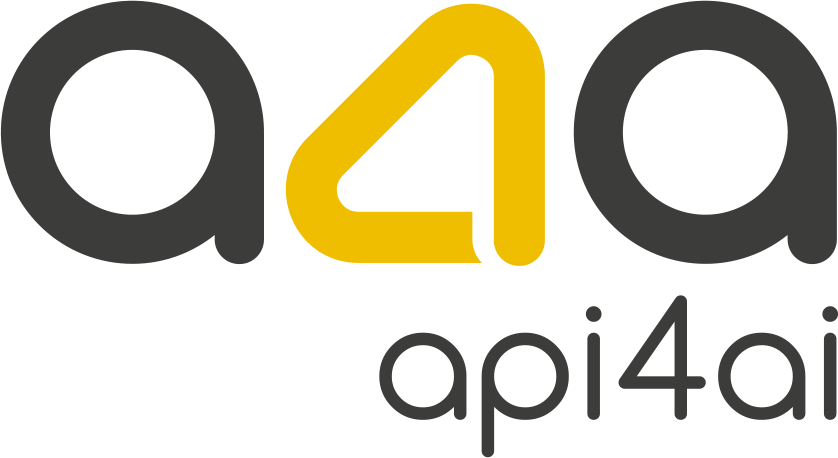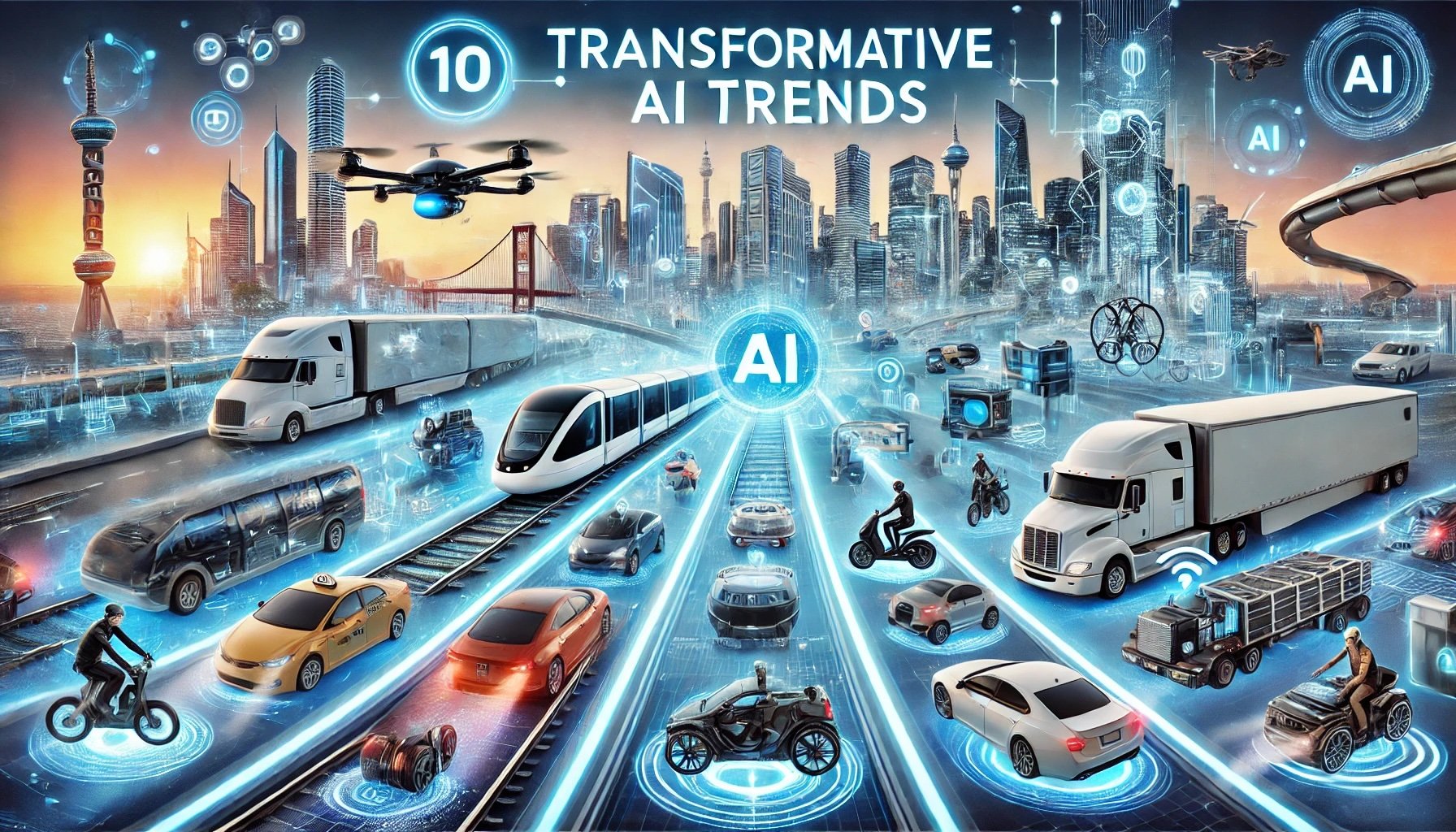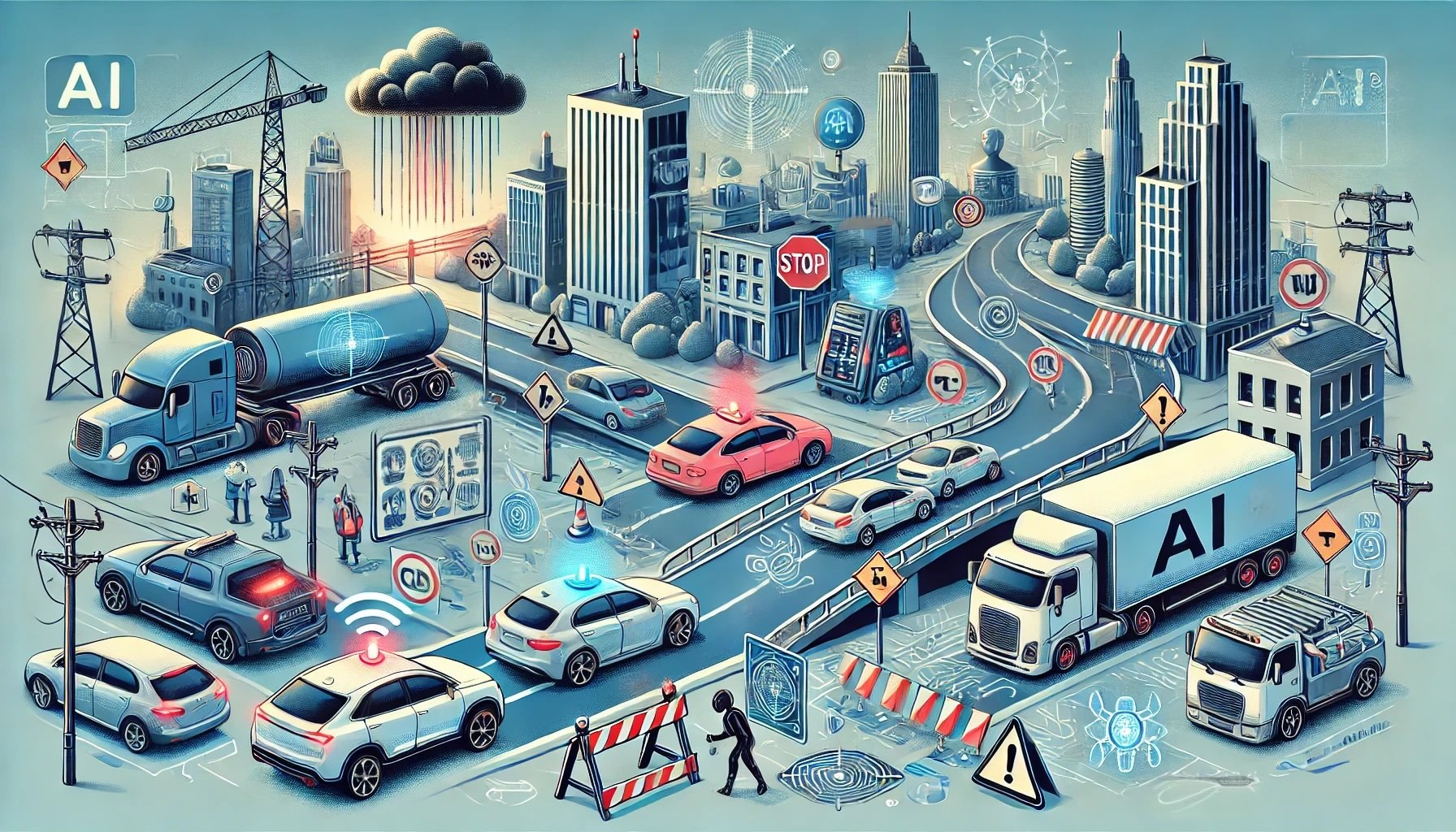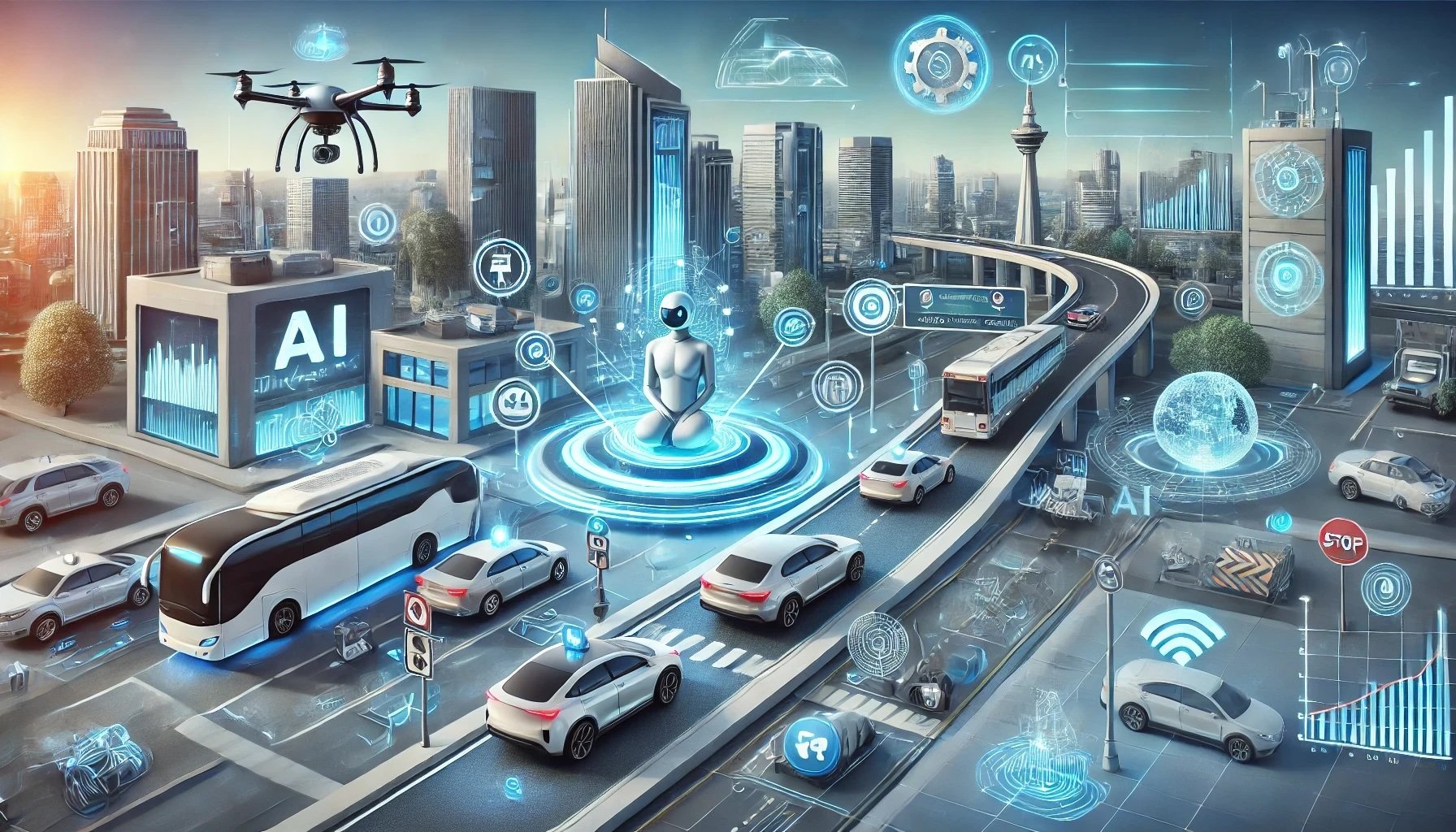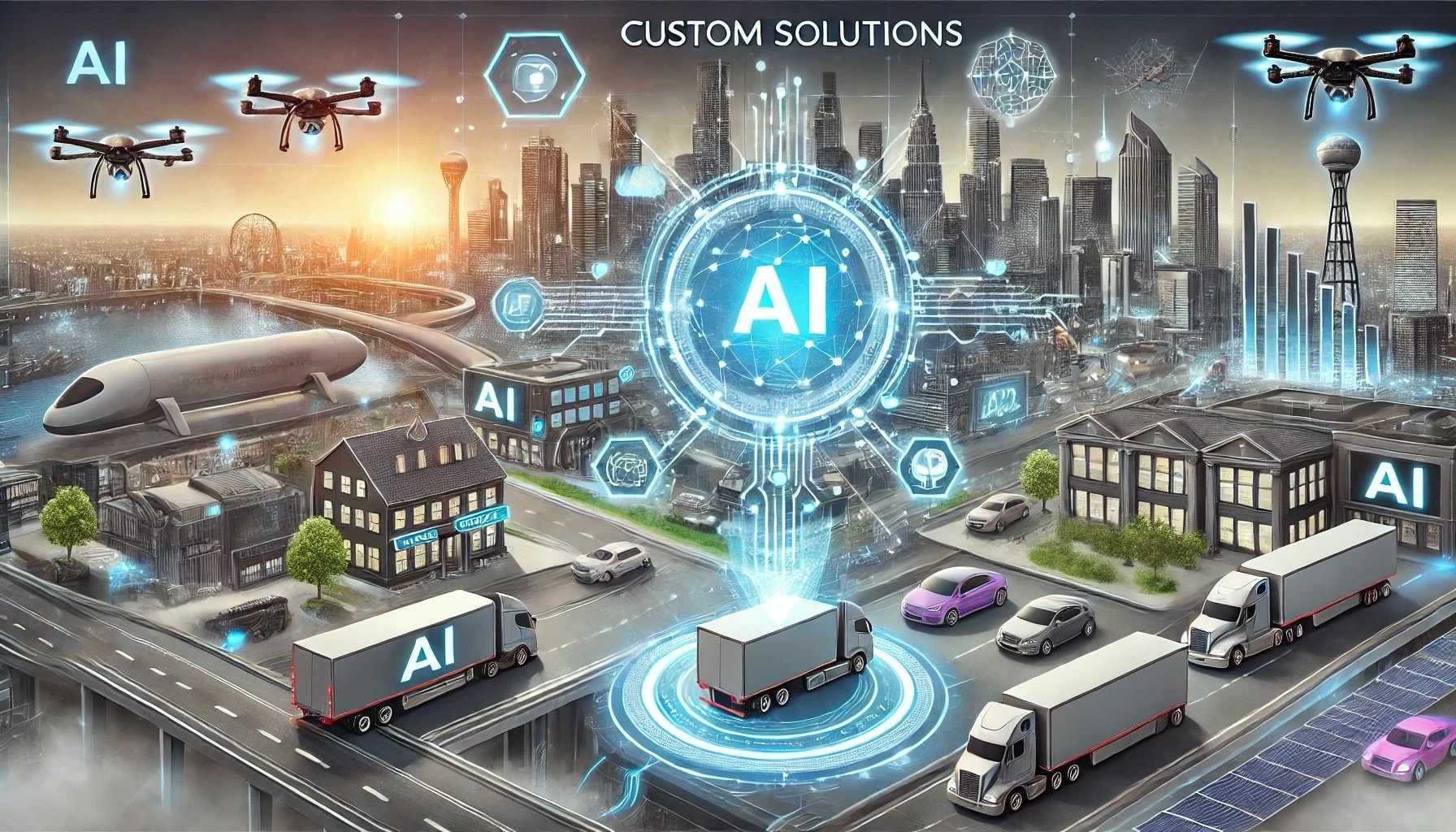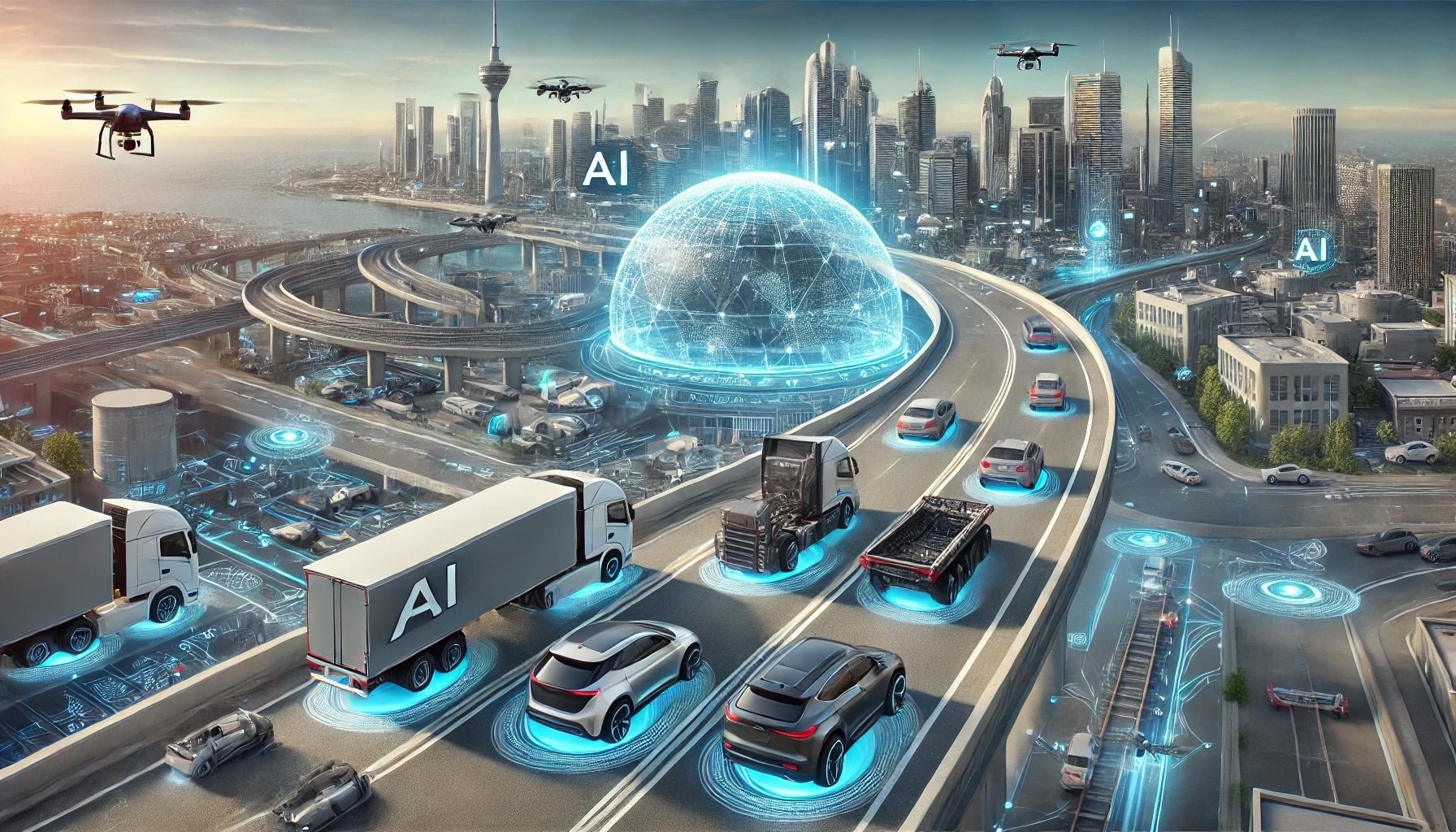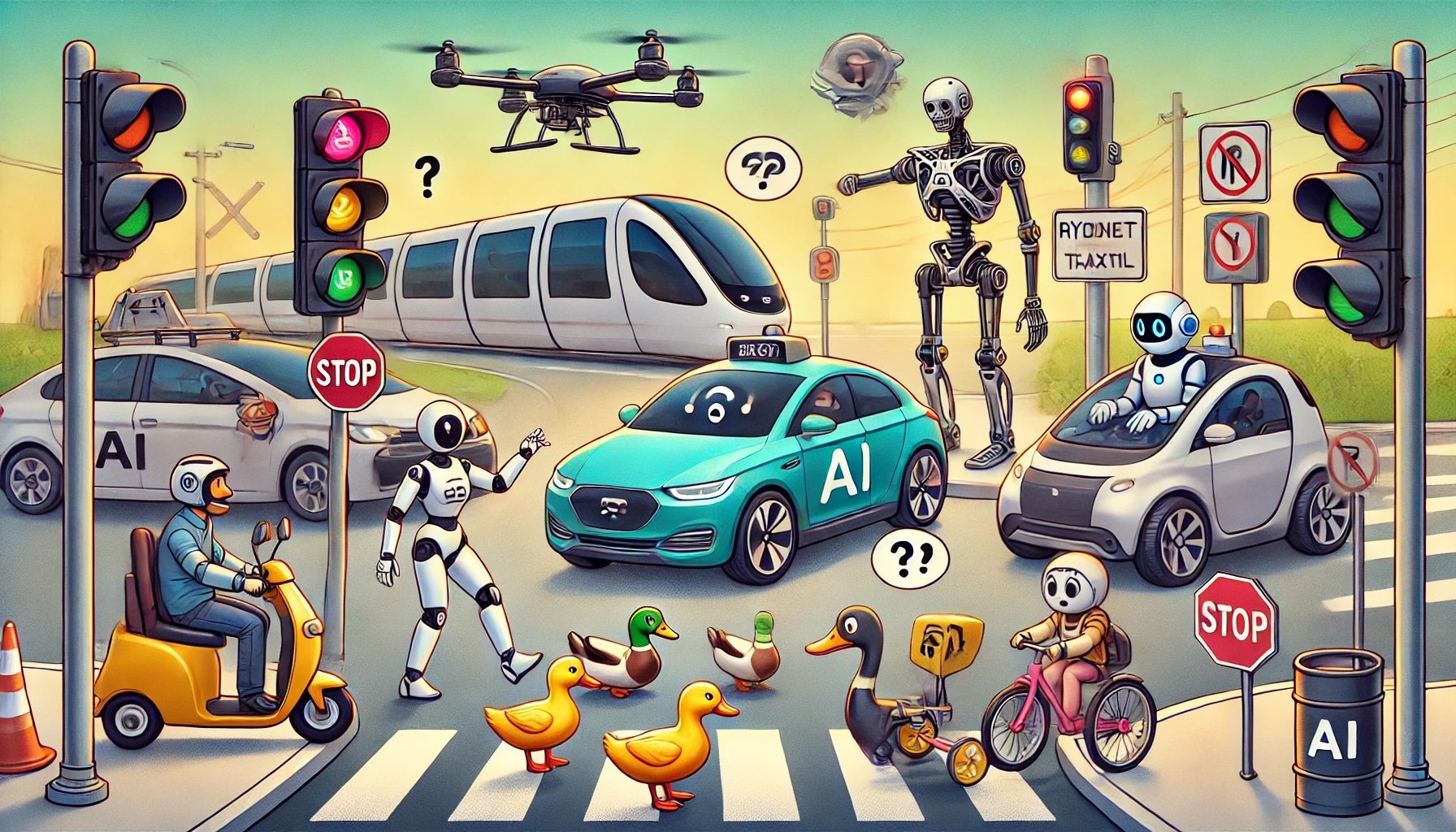10 AI Trends Transforming the Transportation Industry in 2025
Introduction
Setting the Stage
Artificial intelligence is no longer just a futuristic concept — it has become a fundamental part of modern industries. From healthcare to retail, AI is transforming the way businesses operate, improving efficiency, reducing costs and unlocking new opportunities. One sector experiencing some of the most rapid advancements is transportation. AI-driven technologies are redefining how people and goods move, making transportation systems smarter, safer and more efficient.
The demand for intelligent transportation solutions is growing as cities become more crowded, e-commerce expands and consumers expect faster and more reliable services. Companies and governments alike are looking for ways to reduce traffic congestion, lower emissions and improve road safety. AI plays a critical role in this transformation by enabling autonomous vehicles, optimizing traffic flow and enhancing fleet management. Whether it’s self-driving trucks, AI-assisted traffic monitoring or predictive maintenance for public transit, artificial intelligence is at the heart of the industry’s evolution.
As we step into 2025, AI is no longer just an experimental technology for transportation companies — it’s a necessity. Businesses that adopt AI-powered solutions gain a competitive edge by cutting costs, streamlining operations and meeting growing consumer expectations for speed and sustainability. Meanwhile, cities and transportation authorities are leveraging AI to create smarter infrastructure, making roads safer and public transportation more reliable.
The Importance of AI in Transportation
Despite advancements in transportation over the years, many persistent challenges remain. Traffic congestion continues to waste valuable time and fuel. Road safety is still a major concern, with human error being the leading cause of accidents. High operational costs put pressure on logistics companies, public transit systems and rideshare services. AI is now being used to tackle these challenges head-on.
One of the most significant ways AI is reshaping transportation is by improving efficiency. AI-powered route optimization tools help delivery services reduce delays, while predictive maintenance algorithms ensure vehicles are repaired before they break down, preventing costly disruptions. AI is also making transportation safer. Advanced Driver Assistance Systems (ADAS) use computer vision and machine learning to detect hazards and prevent accidents. Meanwhile, AI-driven traffic management solutions are helping cities reduce congestion by analyzing real-time data and adjusting traffic signals accordingly.
Another key area where AI is making an impact is sustainability. With climate change concerns at an all-time high, businesses and governments are looking for ways to lower their carbon footprint. AI-driven logistics and fleet management systems can optimize fuel usage, reduce idle time and even help plan more sustainable urban infrastructure.
In this blog post, we will explore 10 key AI trends that are shaping the future of transportation in 2025. From self-driving freight vehicles to intelligent traffic control systems, these trends are not just theoretical concepts — they are already being implemented and will continue to evolve rapidly. Whether you’re a business leader, a transportation professional or just someone curious about the future of mobility, understanding these AI trends will help you stay ahead in an industry that is changing faster than ever before.
Ten Transformative AI Trends in Transportation
Artificial intelligence is rapidly reshaping transportation, making it smarter, safer and more efficient. From autonomous trucks to AI-driven traffic management, new innovations are addressing some of the biggest challenges in mobility. Below are the ten key AI trends that are set to transform the transportation industry in 2025.
1. Autonomous Freight & Delivery
Self-driving vehicles and robotic delivery solutions are revolutionizing freight transport and last-mile logistics. Autonomous trucks equipped with AI-powered navigation systems can operate continuously without driver fatigue, improving delivery efficiency and reducing costs. In urban areas, robotic couriers and drones are being deployed to handle small package deliveries, minimizing human involvement.
Key Benefits:
Lower labor costs by reducing reliance on human drivers.
Faster and more efficient deliveries, even in high-demand periods.
Reduced human error and accident risks.
Real-World Applications:
Companies like Tesla, Waymo and Einride are developing self-driving freight trucks.
Amazon and FedEx are testing autonomous robots and drones for last-mile deliveries.
2. Advanced Driver Assistance Systems (ADAS)
ADAS is bridging the gap between traditional and fully autonomous vehicles by integrating AI-driven sensors, cameras and radar technology. These systems assist drivers by offering features like adaptive cruise control, lane departure warnings, automatic emergency braking and collision avoidance.
Key Benefits:
Improved road safety by preventing accidents caused by human error.
Reduced driver workload and fatigue, making long-haul trucking safer.
Smoother driving experience with AI-assisted navigation and braking.
Real-World Applications:
Automakers like Tesla, Mercedes-Benz and Volvo offer ADAS features in their latest models.
Regulatory bodies are pushing for mandatory ADAS in commercial fleets to enhance road safety.
3. Intelligent Fleet Management
AI-powered fleet management systems help logistics companies track vehicles, optimize routes and monitor driver performance in real time. These systems use predictive analytics to improve fuel efficiency and ensure on-time deliveries.
Key Benefits:
Lower operational costs by reducing fuel consumption and idle time.
Enhanced customer satisfaction with accurate delivery ETAs.
Improved driver safety through AI-based behavior monitoring.
Real-World Applications:
Logistics companies like UPS and DHL are using AI to optimize routes and cut fuel costs.
AI-driven analytics help fleet managers detect risky driving behaviors and prevent accidents.
4. Smart Traffic Control & Congestion Management
AI-powered traffic management systems are using real-time data from cameras, sensors and GPS to optimize urban mobility. Smart traffic lights adjust based on vehicle flow, while AI algorithms predict congestion patterns and suggest alternative routes.
Key Benefits:
Reduced traffic congestion and lower commute times.
Minimized fuel waste and environmental impact.
Improved road safety through automated traffic monitoring.
Real-World Applications:
Cities like Singapore and Los Angeles are implementing AI-driven traffic systems to ease congestion.
AI-powered toll collection systems are being used to regulate traffic flow dynamically.
5. AI-Powered Predictive Maintenance
Predictive maintenance is helping fleet operators and transit systems prevent costly breakdowns by detecting potential mechanical failures before they happen. AI models analyze sensor data to identify issues with engines, brakes and other critical components.
Key Benefits:
Significant reduction in vehicle downtime and unexpected breakdowns.
Lower maintenance costs by addressing minor issues before they escalate.
Enhanced vehicle lifespan and operational efficiency.
Real-World Applications:
Airlines and rail companies use predictive maintenance to prevent engine failures.
AI-driven diagnostics tools are integrated into fleet management software.
6. Infrastructure Monitoring & Inspection
AI-powered computer vision systems are transforming the way roads, bridges and railways are maintained. Drones and ground-based sensors scan infrastructure for cracks, corrosion or structural weaknesses, triggering automated maintenance alerts.
Key Benefits:
Faster identification of infrastructure defects, preventing accidents.
Reduced manual inspection costs and improved worker safety.
Enhanced longevity of roads, bridges and rail systems.
Real-World Applications:
AI-based road inspection is being implemented in smart cities to detect potholes.
Rail networks use AI-powered cameras to monitor track conditions in real time.
7. Demand Forecasting & Routing
AI-driven analytics can predict travel demand, optimize public transport schedules and dynamically adjust rideshare pricing based on real-time conditions. These insights help companies and city planners allocate resources more effectively.
Key Benefits:
Reduced empty rides and wasted fuel in public transportation and logistics.
Improved service reliability with real-time demand adjustments.
Lower operational costs for transit operators and rideshare platforms.
Real-World Applications:
Uber and Lyft use AI to predict ride demand and adjust pricing dynamically.
Public transit agencies use AI to optimize bus and train schedules.
8. Real-Time Safety Monitoring
AI-powered safety monitoring systems use cameras and sensors to track driver behavior, detect fatigue and prevent accidents. These systems can also monitor passenger safety in public transport, enhancing security.
Key Benefits:
Reduced risk of accidents by identifying drowsy or distracted drivers.
Enhanced passenger safety in buses, trains and ride-hailing services.
Increased accountability for commercial drivers and fleet operators.
Real-World Applications:
AI-powered dash cams are being used in trucking to detect risky driving behavior.
AI surveillance in public transport helps prevent security incidents and vandalism.
9. AI-Optimized Warehousing & Inventory
AI-driven robotics and computer vision systems are streamlining warehouse operations by automating inventory management, sorting and packing processes. AI-powered supply chain analytics also help forecast inventory needs accurately.
Key Benefits:
Faster order fulfillment and reduced warehouse costs.
Minimized human error in stock management.
Optimized supply chain efficiency with AI-driven demand prediction.
Real-World Applications:
E-commerce giants like Amazon and Alibaba use AI-powered robots for warehouse automation.
AI-powered barcode scanning and OCR improve accuracy in logistics hubs.
10. Drone & Aerial Solutions
Drones are being increasingly used in transportation for last-mile delivery, aerial traffic monitoring and infrastructure inspections. AI-powered drone navigation enables them to operate autonomously, even in complex urban environments.
Key Benefits:
Faster deliveries in congested areas and remote locations.
Improved road safety with real-time aerial traffic updates.
Reduced human exposure to hazardous infrastructure inspections.
Real-World Applications:
Companies like Zipline and Wing use drones for medical and e-commerce deliveries.
AI-powered drones assist in inspecting bridges, pipelines and railway tracks.
AI is revolutionizing transportation by improving efficiency, reducing costs and making travel safer. From self-driving freight trucks to AI-powered traffic management, the impact of artificial intelligence will only continue to grow. As more companies adopt these technologies, the transportation industry will become smarter and more responsive to global challenges.
By staying ahead of these AI trends, businesses and policymakers can ensure they remain competitive in an evolving transportation landscape.
Challenges and Considerations
While AI is revolutionizing transportation, its adoption is not without obstacles. From data privacy concerns to regulatory challenges and technical integration issues, businesses and policymakers must navigate several complexities to ensure a smooth and responsible AI-driven transformation. Below are the key challenges that need to be addressed as AI continues to reshape the industry.
1. Data Privacy & Security
AI-powered transportation systems rely heavily on vast amounts of data, including real-time traffic feeds, vehicle diagnostics, geolocation tracking and even facial recognition for driver or passenger identification. While this data is crucial for improving efficiency and safety, it also raises significant privacy and security concerns.
One of the biggest risks is unauthorized data access or breaches, which can expose sensitive information such as passenger travel patterns, fleet locations and personal details. If improperly handled, such data can be exploited for malicious purposes, including identity theft or corporate espionage. Cybersecurity threats, such as hacking attempts on autonomous vehicle networks, can also lead to operational disruptions or even compromise public safety.
To ensure responsible data handling, transportation companies using AI must follow strict privacy regulations like the General Data Protection Regulation (GDPR) in Europe and the California Consumer Privacy Act (CCPA) in the U.S. These regulations require organizations to collect only the necessary data, store it securely and allow users control over their personal information. AI-powered transportation solutions must also integrate strong encryption techniques, anonymization methods and secure cloud storage to prevent data leaks and unauthorized access.
As AI adoption grows, businesses must prioritize data security from the outset rather than treating it as an afterthought. Implementing regular security audits, AI ethics guidelines and transparent data policies will help build trust among users and regulatory authorities.
2. Ethical and Regulatory Hurdles
AI in transportation raises several ethical dilemmas, particularly around autonomous decision-making, safety responsibilities and labor market shifts.
One of the biggest debates revolves around AI-driven decision-making in autonomous vehicles. If a self-driving car is involved in an accident, who is responsible — the manufacturer, the software developer or the fleet owner? Unlike human drivers, AI operates based on pre-programmed logic and real-time learning, which means it may struggle to make ethical choices in high-risk situations, such as deciding between protecting its passengers versus pedestrians in unavoidable collisions. These challenges require clear legal frameworks that define accountability and liability for AI-driven systems.
Another significant issue is job displacement. The widespread adoption of AI in transportation — particularly in freight, delivery and ridesharing — raises concerns about reducing employment opportunities for human drivers. While AI will create new job roles in system maintenance, AI oversight and data analysis, many workers will need to reskill to stay relevant in the evolving industry. Governments and businesses must work together to provide education and workforce transition programs to help employees adapt to this shift.
The regulatory landscape for AI in transportation is still evolving and different countries are moving at different speeds. While some nations are actively testing and legalizing autonomous vehicles, others are implementing strict controls and cautious rollouts due to safety concerns. The lack of unified global regulations makes it challenging for AI-driven transportation companies to scale their solutions across multiple regions. As AI technology advances, harmonizing regulatory policies will be crucial to ensuring safe and consistent adoption across borders.
3. Integration & Interoperability
Many transportation companies operate on legacy systems that were not designed to accommodate AI-driven solutions. This creates a major technical challenge when integrating modern AI technologies into existing fleets, logistics networks and infrastructure.
For example, a logistics company may already use GPS tracking and manual scheduling software. Introducing AI-powered real-time fleet optimization and predictive maintenance tools requires seamless data exchange between new and old systems. However, legacy software may lack compatibility with AI-based cloud solutions, leading to inefficiencies, additional costs and operational disruptions.
Another major hurdle is the absence of universal AI standards and protocols. Different transportation companies, city governments and logistics providers use varying software architectures, hardware components and data formats. Without common industry standards, interoperability issues arise, making it difficult for AI-powered traffic systems, fleet management software and autonomous vehicles to communicate effectively.
To address these challenges, businesses and policymakers need to develop industry-wide standards that allow for smooth AI adoption. This includes:
API-based integration frameworks that allow AI-driven software to connect with existing transportation management systems.
Adoption of cloud-based AI solutions that can be scaled across multiple platforms.
Investment in AI-compatible hardware, such as smart cameras, IoT sensors and connected infrastructure, to support AI-based decision-making.
Companies that take a strategic approach to AI integration — by modernizing outdated infrastructure and adopting flexible AI-friendly systems — will be in a stronger position to leverage AI’s full potential while minimizing compatibility issues.
While AI has the power to revolutionize transportation, challenges such as data security, ethical concerns and system integration must be carefully addressed. Ensuring responsible AI development, complying with data privacy laws and establishing clear industry regulations will be key to fostering trust and accelerating AI adoption.
At the same time, businesses must invest in flexible AI-driven solutions that seamlessly integrate with existing transportation systems. By overcoming these hurdles, AI-powered transportation can truly fulfill its promise of safer roads, efficient mobility and smarter logistics in the years ahead.
Optimizing with Image Processing
AI-powered image processing is playing a crucial role in transforming the transportation industry. From vehicle identification and accident detection to cargo inspection and security monitoring, computer vision is making transportation systems smarter, safer and more efficient. By analyzing visual data in real time, AI-driven image processing helps businesses automate key operations, reduce human errors and optimize workflows.
1. Role of Computer Vision in Transportation
Computer vision, a branch of AI that enables machines to interpret and analyze visual information, is proving to be a game-changer in transportation. By processing images and videos from cameras, drones and IoT sensors, AI-powered image recognition systems can detect patterns, classify objects and make intelligent decisions in real time. This technology is already being used across various transportation applications to improve efficiency, safety and compliance.
One of the most impactful applications of computer vision in transportation is vehicle identification. AI-powered cameras can automatically recognize license plates, vehicle types and fleet branding, allowing for automated toll collection, parking management and traffic enforcement. This reduces the need for manual intervention and speeds up processes.
Another critical use case is accident detection and traffic violation monitoring. Smart surveillance cameras, combined with AI-based image recognition, can identify speeding vehicles, illegal lane changes and red-light violations. By integrating these systems with law enforcement databases, authorities can issue automated fines and improve road safety.
Computer vision also plays a crucial role in cargo inspection and logistics. AI-driven image analysis can scan shipping containers, detect damages and verify product quantities without the need for manual checks. This is particularly useful in ports, warehouses and freight transport hubs, where large volumes of goods need to be processed quickly and accurately.
At security checkpoints, AI-powered imaging solutions enhance passenger screening, baggage inspection and vehicle scanning at airports, border crossings and high-security areas. With real-time object detection capabilities, AI can quickly identify prohibited items or suspicious activities, helping security teams respond swiftly.
As the transportation industry continues to evolve, AI-powered image processing will become an essential tool for automation, compliance and safety improvements.
2. Ready-to-Use Image Processing Solutions
Many transportation companies are already integrating ready-to-use AI APIs to enhance their operations. Instead of building AI solutions from scratch, businesses can leverage pre-built image processing APIs that accelerate development, reduce costs and ensure high accuracy. Below are some of the most common use cases where AI-powered image recognition is making a difference:
Optical Character Recognition (OCR) for License Plates and Shipping Labels
AI-powered OCR technology can automatically extract text from images, making it ideal for license plate recognition, shipping labels and invoice processing. This is widely used in:
Automated toll collection systems that read license plates to charge vehicles without stopping.
Fleet tracking and security monitoring, where license plate data is matched against vehicle records.
Logistics and shipping, where OCR extracts details from package labels for automated sorting and tracking.
Background Removal for Product Images in Logistics
Background removal technology helps e-commerce and logistics companies enhance product presentation. This is particularly useful in:
Online vehicle marketplaces, where car dealers need high-quality images with a clean background for better visibility.
Warehouse inventory management, where items are cataloged with professional-looking images to improve tracking and auditing.
Automated vehicle advertising, where AI removes cluttered backgrounds and standardizes product listings.
Object Detection for Road Hazards and Identifying Damages
AI-powered object detection plays a crucial role in road safety and fleet maintenance by identifying:
Potholes, debris and road obstacles that may pose risks to drivers.
Vehicle damages in insurance claims, where AI can assess dents, scratches and broken parts from images.
Traffic violations, such as unauthorized lane usage or parking in restricted zones.
By integrating object detection APIs, transportation authorities and logistics companies can proactively monitor road conditions and reduce accident risks.
Brand Logo Recognition for Transport Fleets
AI-powered brand logo recognition ensures brand compliance and unauthorized use monitoring in commercial transportation. This is valuable for:
Fleet branding enforcement, where AI verifies if company logos on vehicles meet brand standards.
Advertisement tracking, where brands monitor the visibility of their logos on public transport, taxis and delivery trucks.
Preventing counterfeits, where AI scans product packaging in transit to identify unauthorized branding or tampering.
Accelerating AI Adoption with Pre-Built APIs
One of the key advantages of using ready-made AI image processing APIs is the ability to deploy solutions quickly without needing deep AI expertise. These APIs offer:
Faster development cycles, allowing businesses to integrate AI within weeks instead of months.
Cost efficiency, eliminating the need for large AI development teams and extensive R&D budgets.
Scalability, as cloud-based APIs can handle increasing data volumes without major infrastructure investments.
By adopting AI-powered image processing, transportation companies can enhance automation, reduce manual workload and optimize operational efficiency. As AI technology continues to evolve, leveraging computer vision solutions will be key to staying ahead in an increasingly competitive industry.
Custom AI Solutions for Future Growth
As AI-powered technologies continue to revolutionize transportation, businesses face an important decision: should they rely on off-the-shelf AI solutions or invest in custom-built models tailored to their specific needs? While ready-made AI tools can provide immediate benefits, custom AI solutions offer greater flexibility, accuracy and long-term value, especially for companies with unique operational challenges. Investing in tailor-made AI models can lead to higher efficiency, cost savings and a competitive advantage, making it a strategic move for companies looking to scale.
1. Tailored AI Models for Industry-Specific Challenges
Off-the-shelf AI solutions — such as pre-built image recognition APIs, object detection tools or fleet management software — are excellent for businesses that need quick and easy AI integration. These solutions work well for standard use cases like license plate recognition, package tracking or automated background removal. However, transportation companies often face challenges that generic AI models cannot fully address.
Custom AI models provide a higher level of precision and adaptability by being trained on company-specific data. This allows businesses to:
Fine-tune AI algorithms for unique operational needs, such as detecting cargo damages under specific lighting conditions or optimizing traffic flow for particular city layouts.
Increase accuracy by training AI on proprietary datasets rather than relying on generalized data from pre-built models.
Adapt AI systems to evolving industry requirements, ensuring long-term sustainability.
For example, a logistics company may require an AI model that identifies and categorizes different types of shipping containers based on size, shape and condition. A generic object detection API might struggle to differentiate between slight variations in container types, whereas a custom-trained AI model can achieve near-perfect accuracy, reducing sorting errors and improving inventory management.
Scalability is another key advantage of custom AI solutions. As a business grows, so do its data processing needs. Custom-built models can be continuously updated and optimized, ensuring that the AI system evolves alongside the company. By contrast, off-the-shelf solutions may become limited in functionality over time, requiring companies to switch platforms or work around constraints.
In the long run, custom AI development offers a higher return on investment (ROI) because it ensures that the technology aligns precisely with business goals. While it may take longer to develop and deploy, a tailored AI model ultimately leads to better efficiency, fewer errors and greater automation capabilities.
2. Balancing Investment and Returns
One of the main concerns businesses have about custom AI development is the upfront cost. Unlike ready-made solutions, which often operate on a subscription or pay-per-use model, custom AI solutions require an initial investment in development, training and deployment. However, when implemented strategically, these solutions can significantly reduce costs and increase profitability in the long run.
Here’s how businesses can balance investment and returns when adopting custom AI models:
Lower Operational Costs Over Time
Custom AI solutions help automate repetitive tasks, reduce manual labor and optimize resource allocation. For instance, an AI-powered predictive maintenance system can lower fleet maintenance costs by preventing unexpected breakdowns, saving thousands of dollars in repair expenses and downtime.Competitive Advantage Through AI-Driven Insights
Companies that invest in custom AI gain unique insights into their operations, allowing them to make smarter business decisions. A personalized AI-powered logistics model can dynamically adjust delivery schedules, optimize warehouse storage and predict supply chain disruptions, giving businesses an edge over competitors using generic solutions.Long-Term Scalability and Adaptability
Off-the-shelf AI solutions may work well in the short term, but as companies expand, they often require custom features that are not available in standard APIs. Investing in custom AI ensures continuous improvement and adaptability, allowing businesses to integrate new technologies without major disruptions.Higher Accuracy, Fewer Errors
A transportation company that relies on AI for accident detection and risk assessment will benefit from a model trained on real-world accident scenarios from their specific fleet. This results in fewer false positives, improved decision-making and reduced liability risks, ultimately saving money on insurance claims and compliance penalties.Potential for New Revenue Streams
Some businesses that develop custom AI models find additional opportunities to license or resell their AI-powered technology. A large-scale logistics company that creates an advanced AI-based warehouse automation system could later offer it as a software service to smaller logistics firms, creating a new revenue stream.
While the initial investment in custom AI development may seem significant, companies that take a long-term perspective will see substantial cost savings, improved efficiency and greater profitability. By carefully evaluating their needs and working with AI experts to build tailored solutions, businesses can future-proof their operations and stay ahead of industry trends.
AI is already transforming transportation, but businesses looking for long-term growth and a competitive edge should consider custom AI development over one-size-fits-all solutions. While off-the-shelf AI tools offer quick deployment, they often lack the precision, flexibility and scalability required for complex industry-specific challenges.
Investing in custom AI solutions may require an upfront commitment, but the benefits — higher accuracy, lower operational costs, improved scalability and long-term adaptability — far outweigh the initial costs. By strategically integrating tailored AI models, transportation companies can unlock new efficiencies, improve decision-making and maximize their return on investment in the years ahead.
The Competitive Edge
Artificial intelligence is no longer just an experimental technology in transportation — it’s becoming a necessity for companies looking to stay ahead in an increasingly competitive landscape. Businesses that embrace AI early gain a significant advantage, not only in efficiency and cost savings but also in market positioning and long-term growth. The transportation sector is undergoing rapid shifts and organizations that fail to adopt AI-driven innovations risk falling behind.
From automated fleet management to predictive analytics and AI-powered logistics, companies that invest in smart technology are setting new industry standards. Below, we explore how early adoption and continuous AI evolution are shaping the competitive landscape of transportation.
1. Industry Shifts & Early Adopters
The transportation industry is experiencing a major transformation driven by autonomous vehicles, smart logistics, AI-powered infrastructure monitoring and predictive analytics. Companies that invest in AI solutions today are positioning themselves as leaders for the future. Early adopters of AI in transportation are already seeing significant benefits in terms of cost reductions, efficiency improvements and customer satisfaction.
The Market Advantage of Early AI Adoption
Increased Efficiency – AI-powered route optimization, automated vehicle diagnostics and predictive maintenance reduce downtime and fuel consumption, leading to lower operational costs.
Higher Profit Margins – Businesses that use AI to streamline supply chain logistics, warehouse automation and demand forecasting can scale operations more effectively without increasing costs.
Enhanced Customer Experience – AI-driven personalization, automated chatbots and real-time shipment tracking improve service quality and customer satisfaction.
Regulatory Compliance & Risk Mitigation – AI helps companies stay ahead of evolving safety and environmental regulations by ensuring real-time monitoring and reporting of vehicle emissions, road safety and driver compliance.
A great example of early adoption is automated freight companies that are already leveraging self-driving trucks and AI-powered logistics to gain an upper hand over traditional transport businesses. Companies like Tesla, Waymo and Embark Trucks are investing in AI-driven freight solutions, which give them an edge over competitors that still rely on manual processes and outdated technology.
Data-Driven Decision Making as a Competitive Advantage
AI-powered analytics allow transportation companies to make informed, data-driven decisions, leading to more precise demand forecasting, risk assessment and investment strategies. This fosters greater trust among stakeholders, including customers, investors and regulators.
For example:
Investors are more likely to support companies that use AI for data-driven business models, ensuring higher returns and scalability.
Regulators favor businesses that proactively adopt AI for compliance and sustainability, such as automated emissions monitoring and real-time road safety tracking.
Customers prefer transportation providers that offer faster deliveries, better tracking systems and AI-driven personalized services, such as dynamic pricing for rideshare users or AI-optimized public transit schedules.
The companies that act early and build AI-driven solutions into their core operations are already establishing themselves as market leaders, setting the standard for others to follow.
2. Continuous Evolution of AI Technologies
While adopting AI early provides an advantage, staying competitive requires continuous learning and adaptation. AI is evolving rapidly and businesses that fail to keep up with the latest advancements may lose their edge over time.
Why Ongoing AI Innovation is Crucial
AI models need regular updates to maintain accuracy and efficiency. Without frequent improvements, AI-powered tools like predictive maintenance, traffic optimization or warehouse automation may become outdated.
New AI capabilities emerge constantly. Companies that remain agile and integrate emerging technologies — such as AI-powered edge computing for real-time vehicle diagnostics — can unlock new efficiencies that competitors may overlook.
Regulatory changes can reshape AI applications. As governments introduce new AI ethics, data privacy and transportation safety regulations, companies must adapt their AI solutions to remain compliant and competitive.
Adapting to AI Innovations to Stay Ahead
Businesses that continuously refine their AI strategies can introduce new service offerings and expand their market influence. For example:
Autonomous ride-sharing companies that use AI to predict peak demand, optimize pricing and enhance passenger safety will have an edge over competitors with static pricing models and basic GPS routing.
Freight and logistics companies that integrate AI-powered robotics in warehouses and last-mile delivery will outpace rivals still relying on manual sorting and inefficient dispatch systems.
AI-driven urban traffic management systems that dynamically adjust signals and reroute vehicles based on real-time congestion data will significantly improve city-wide mobility, giving municipalities using them a major competitive advantage.
The Role of AI in Future-Proofing Businesses
The most successful transportation companies will be those that treat AI adoption as an ongoing strategy rather than a one-time investment. They will regularly evaluate new AI capabilities, refine their machine learning models and invest in scalable AI infrastructures that can grow with their business.
Future-focused companies are already leveraging AI for real-time traffic analytics, automated quality control in vehicle manufacturing and AI-powered fleet security monitoring. By continually refining their AI tools and adapting to new technological breakthroughs, these companies ensure they stay ahead of the competition and drive innovation in the transportation industry.
AI is no longer an optional enhancement in transportation — it is a fundamental driver of efficiency, safety and profitability. Companies that adopt AI early gain a competitive advantage in cost reduction, customer satisfaction and operational intelligence. However, true market leadership comes from continuous AI adaptation and innovation.
The businesses that actively refine their AI models, stay updated on emerging technologies and adjust to evolving regulations will be the ones leading the industry in the coming years. Those that fail to embrace AI advancements and adapt to industry shifts risk being left behind.
For transportation companies looking to future-proof their operations, gain market share and stay ahead of competitors, AI is not just an opportunity — it is a necessity.
Conclusion
The transportation industry is undergoing a transformation and artificial intelligence is at the heart of this evolution. From optimizing logistics and reducing congestion to improving safety and automating fleet operations, AI is reshaping the way people and goods move. The companies that embrace these changes now will not only improve their operational efficiency but also gain a competitive edge in an increasingly AI-driven world.
Key Takeaways
Throughout this blog post, we explored 10 AI trends that are set to redefine transportation in 2025. These include autonomous freight and delivery systems, advanced driver assistance, intelligent fleet management, AI-driven predictive maintenance and smart traffic control. Each of these trends is addressing long-standing industry challenges such as high operational costs, road safety concerns and environmental impact.
Computer vision, predictive analytics and machine learning are playing a crucial role in this transformation. AI-powered image processing technologies are helping businesses automate vehicle identification, accident detection, cargo inspection and warehouse management. Predictive models are reducing downtime by preventing vehicle breakdowns, improving traffic flow and optimizing public transport schedules.
By integrating these AI-driven solutions, transportation companies, logistics providers and city planners can enhance efficiency, minimize costs and create safer and more sustainable mobility systems.
Looking Ahead
The future of transportation belongs to those who embrace AI innovation and adapt to technological advancements. However, simply adopting AI is not enough — companies need a well-defined strategy to ensure seamless integration and long-term success. This includes:
Continuously evaluating and refining AI models to improve performance and accuracy.
Building strategic partnerships with AI solution providers to gain access to cutting-edge technology.
Investing in custom AI solutions that align with specific operational requirements rather than relying on one-size-fits-all approaches.
Staying informed on regulatory changes and ethical considerations to ensure compliance and responsible AI deployment.
As AI continues to evolve, organizations that actively engage with emerging technologies will be the ones shaping the future of transportation. Whether it’s an autonomous vehicle fleet, AI-powered traffic management or predictive logistics planning, those who lead in AI adoption will set new industry standards.
Call to Action
Now is the time for transportation businesses, logistics providers and policymakers to assess their current processes and identify opportunities where AI can drive improvements. Companies that act early will benefit from:
Faster and more efficient operations
Reduced costs through automation and predictive maintenance
Enhanced safety for drivers, passengers and cargo
Greater scalability and adaptability to industry shifts
If your organization is looking to leverage AI-driven solutions, expert teams are available to help design, develop and deploy custom AI models tailored to your unique business needs. Whether you need advanced image processing for fleet monitoring, predictive analytics for logistics or AI-powered automation for safety compliance, the right solutions can help future-proof your business.
The transportation industry is on the brink of a new era and AI is the driving force behind its transformation. The question is not whether to adopt AI — but how quickly your business can take advantage of its potential.
